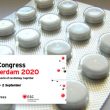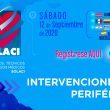Do not miss the next SOLACI Research event, where we will be presenting LATAM Peripheral Research Registry! This registry is meant to collect data and clinical information about peripheral vascular disease across Latin America to determine the best evidence-based therapies. This is why we are carrying out a live virtual event you cannot miss, where<a href="https://solaci.org/en/2021/05/07/12-05-solaci-research-webinar-lower-limb-angioplasty-latam-peripheral-registry/" title="Read more" >...</a>
SOLACI PERIPHERAL | 6th Clinical Case: Common, Superficial and Deep Femoral Artery Recanalization
Here is a new SOLACI PERIPHERAL Case! In this opportunity, Dr. Ana Paula Mollón (Arg.) presents “Common, Superficial and Deep Femoral Artery Recanalization”. This is the 6th clinical case presented by SOLACI Peripheral. The purpose of this space is to encourage and further the exchange of experiences and opinions, to keep advancing our knowledge in<a href="https://solaci.org/en/2021/04/06/solaci-peripheral-6th-clinical-case-common-superficial-and-deep-femoral-artery-recanalization/" title="Read more" >...</a>
Optimal Medical Treatment Under-used in Vascular Peripheral Disease
Less than half of patients undergoing endovascular revascularization for peripheral artery disease to their lower limbs are discharged with optimal medical treatment. Their traditional risk factors are predictors of a more comprehensive treatment; however, women, patients with higher risk of thrombosis, and those more likely to lose a lower limb, are far from being treated<a href="https://solaci.org/en/2021/01/28/optimal-medical-treatment-under-used-in-vascular-peripheral-disease/" title="Read more" >...</a>
Diabetes and Peripheral Vascular Disease: Old Drugs, New Evidence
This paper, recently published in JAHA, showed that patients with type 2 diabetes mellitus exhibiting lower-limb vascular disease benefit from combining cilostazol and clopidogrel. Treatment for at least 6 months with clopidogrel (75 mg/QD) plus cilostazol (100 mg/BID) significantly reduces ischemic events—including stroke, infarction, and death from vascular causes—compared with clopidogrel monotherapy. Adding cilostazol reduces ischemic events, but that<a href="https://solaci.org/en/2021/01/07/diabetes-and-peripheral-vascular-disease-old-drugs-new-evidence/" title="Read more" >...</a>
SOLACI PERIPHERAL | 5th Clinical Case: Abdominal Aortic Aneurysm with Hostile Neck
New clinical case from SOLACI PERIPHERAL! This time, we present a case featuring an abdominal aortic aneurysm with hostile neck. With this, we wrap up an intense year during which we published 5 clinical cases to deepen and stimulate the exchange between Latin American interventionist colleagues. Tell us what you think about this case using<a href="https://solaci.org/en/2020/12/23/solaci-peripheral-5th-clinical-case-abdominal-aortic-aneurysm-with-hostile-neck/" title="Read more" >...</a>
The Key We Are Overlooking in Peripheral Vascular Disease
To change the prognosis of peripheral vascular disease patients, a referral for supervised exercise is paramount. This should be a cultural change, not only an individual recommendation. A physically active lifestyle reduces the risk of cardiovascular events and functional impairment in patients with peripheral vascular disease. The novelty of this work (forthcoming in Eur J<a href="https://solaci.org/en/2020/10/07/the-key-we-are-overlooking-in-peripheral-vascular-disease/" title="Read more" >...</a>
SOLACI PERIPHERAL | 4th Clinical Case: Thoracic Aortic Dissection in Patient with Complex Arch
A new clinical case to keep learning with colleagues! Today, we present a Thoracic Aortic Dissection in Patient with Complex Arch. This is the 4th case for SOLACI Peripheral, which continues its mission: to deepen knowledge exchange among Latin American interventional cardiologists. Tell us what you think about this case using the comments section in this<a href="https://solaci.org/en/2020/09/28/solaci-peripheral-4th-clinical-case-thoracic-aortic-dissection-in-patient-with-complex-arch/" title="Read more" >...</a>
Evidence or Theory? Antiaggregation Scheme after Peripheral Vascular Intervention
Antiaggregation indication after peripheral intervention (PVI) can vary up to 50% depending on center, operator, and procedure. This highlights the huge variation in indication and the scarce evidence there is on this matter. Most cardiologists would like to simply transfer the information from the coronaries to the superficial femoral, but we can confirm this does<a href="https://solaci.org/en/2020/09/15/evidence-or-theory-antiaggregation-scheme-after-peripheral-vascular-intervention/" title="Read more" >...</a>
ESC 2020 | Rivaroxaban Might Reduce Cardiac Cerebral and Peripheral Events
Adding rivaroxaban to the standard treatment might reduce events incidence in lower limbs, heart, and brain, in patients with peripheral vascular disease undergoing revascularization. These new data resulted from the analysis of the VOYAGER PAD subgroups and were presented at the virtual ESC 2020. The COMPASS study had reached similar conclusions using 2.5 mg rivaroxaban<a href="https://solaci.org/en/2020/09/09/esc-2020-rivaroxaban-might-reduce-cardiac-cerebral-and-peripheral-events/" title="Read more" >...</a>
SOLACI Webinar | Peripheral interventionism
We are interested in your opinion. Please, leave your comments, thoughts, questions, etc., below. They will be most welcome.









